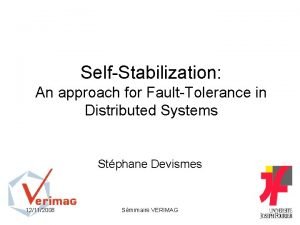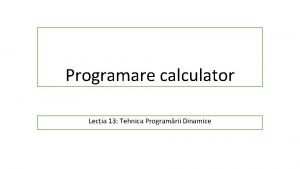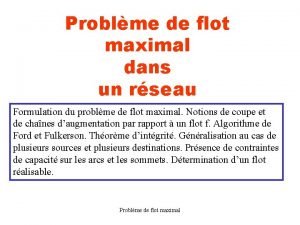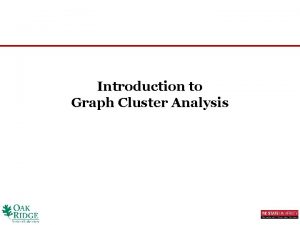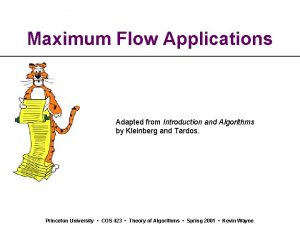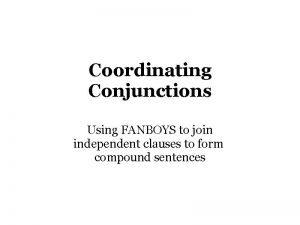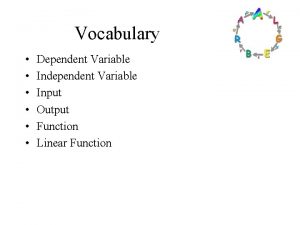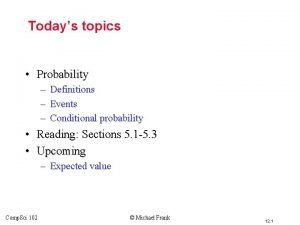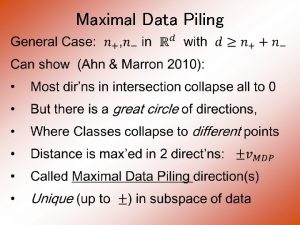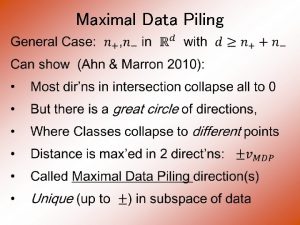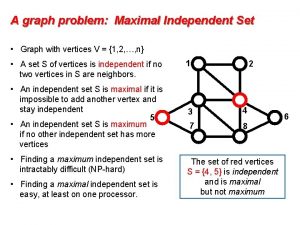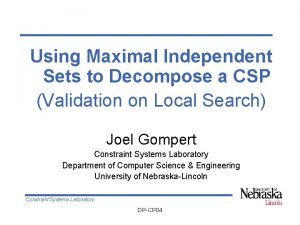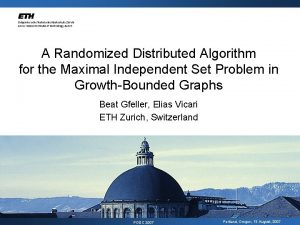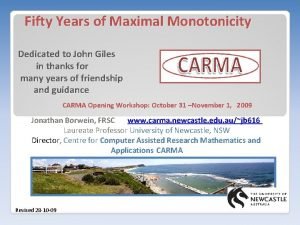Maximal Independent Set 1 Independent Set IS In

















































- Slides: 49

Maximal Independent Set 1

Independent Set (IS): In a graph, any set of nodes that are not adjacent 2

Maximal Independent Set (MIS): An independent set that is no subset of any other independent set 3

Maximum Independent Set: A MIS of maximum size A graph G… …a MIS of max size 4

Applications in Distributed Systems • In a network graph consisting of nodes representing processors, a MIS defines a set of processors which can operate in parallel without interference • For instance, in wireless ad hoc networks, to avoid interference, a conflict graph is built, and a MIS on that defines a clustering of the nodes enabling efficient routing 5

A Sequential Greedy algorithm Suppose that will hold the final MIS Initially 6

Phase 1: Pick a node and add it to 7

Remove and neighbors 8

Remove and neighbors 9

Phase 2: Pick a node and add it to 10

Remove and neighbors 11

Remove and neighbors 12

Phases 3, 4, 5, …: Repeat until all nodes are removed 13

Phases 3, 4, 5, …, x: Repeat until all nodes are removed No remaining nodes 14

At the end, set will be an MIS of 15

Running time of the algorithm: Θ(|E|) Number of phases of the algorithm: O(n) Worst case graph (for number of phases): nodes 16

Homework Can you see a distributed version of the algorithm just given? 17

A General Algorithm For Computing MIS Same as the sequential greedy algorithm, but at each phase we may select any independent set (instead of a single node) 18

Example: Suppose that will hold the final MIS Initially 19

Phase 1: Find any independent set And insert to : 20

remove and neighbors 21

remove and neighbors 22

remove and neighbors 23

Phase 2: On new graph Find any independent set And insert to : 24

remove and neighbors 25

remove and neighbors 26

Phase 3: On new graph Find any independent set And insert to : 27

remove and neighbors 28

remove and neighbors No nodes are left 29

Final MIS 30

Observation: The number of phases depends on the choice of independent set in each phase: The larger the independent set at each phase, the faster the algorithm 31

Example: If is MIS, 1 phase is needed Example: If each contains one node, phases are needed (sequential greedy algorithm) 32

A Randomized Sync. Distributed Algorithm Follows the general MIS algorithm paradigm, by choosing randomly at each phase the independent set, in such a way that it is expected to include many nodes of the remaining graph 33

Let be the maximum node degree in the whole graph 1 2 Suppose that d is known to all the nodes (this may require a pre-processing) 34

At each phase : Each node with probability 1 elects itself 2 Elected nodes are candidates for independent set 35

However, it is possible that neighbor nodes may be elected simultaneously Problematic nodes 36

All the problematic nodes must be un-elected. The remaining elected nodes form independent set 37

Analysis: Success for a node in phase disappears at end of phase (enters or ) A good scenario that guarantees success : No neighbor elects itself 1 2 elects itself 38

Basics of Probability E: finite universe of events; let A and B denote two events in E; then: 1. A B is the event that A or (non-exclusive) B occurs; 2. A B is the event that both A and B occur. 39

Probability of success in a phase: At least No neighbor should elect itself 1 2 elects itself 40

Fundamental inequalities 41

Probability of success in phase: At least First (left) ineq. with t =-1 For 42

Therefore, node disappears at the end of phase with probability at least 1 2 43

Expected number of phases until node disappears: at most phases 44

Definition: Bad event for node after node : phases did not disappear This happens with probability (first (right) ineq. with t =-1 and n =2 ed): 45

Bad event for G: after phases at least one node did not disappear This happens with probability: P(ORx G(bad event for x)) ≤ 46

Good event for G: within phases all nodes disappear This happens with probability: (high probability) 47

Total number of phases: (with high probability) # rounds for each phase: 3 1. In round 1, each node tries to elect itself and notifies neighbors; 2. In round 2, each node receives notifications from neighbors, decide whether is in Ik, and notifies neighbors; 3. In round 3, each node receiving notifications from elected neighbors, realizes to be in N(Ik). total # of rounds: 48

Homework Can you provide a good bound on the number of messages? 49
 Maximal independent set
Maximal independent set Total set awareness set consideration set
Total set awareness set consideration set Training set validation set test set
Training set validation set test set Reverse image search
Reverse image search Point of maximal impulse
Point of maximal impulse Heart rate clicker
Heart rate clicker Metoda programarii dinamice
Metoda programarii dinamice Flot maximal
Flot maximal Maximal 2 testovi
Maximal 2 testovi Flujo maximo
Flujo maximo Frequent pattern
Frequent pattern Cluster analysis graph
Cluster analysis graph Heart sounds location
Heart sounds location Maximal flow
Maximal flow Maximal onset principle example
Maximal onset principle example Maximum onset principle
Maximum onset principle Maximal heart rate
Maximal heart rate Webtopings
Webtopings Lsvt big maximal daily exercises
Lsvt big maximal daily exercises Matching graph theory
Matching graph theory Two main clauses
Two main clauses What is an independent set in a graph
What is an independent set in a graph Independent set
Independent set Maximum size of independent set is
Maximum size of independent set is Crisp set vs fuzzy set
Crisp set vs fuzzy set Bounded set vs centered set
Bounded set vs centered set What is the overlap of data set 1 and data set 2?
What is the overlap of data set 1 and data set 2? Fucntions
Fucntions Correspondence function examples
Correspondence function examples Crisp set vs fuzzy set
Crisp set vs fuzzy set How to identify independent and dependent variable
How to identify independent and dependent variable Independent t test example
Independent t test example Hiccup sentence
Hiccup sentence In marshmallow muscles what is the independent variable
In marshmallow muscles what is the independent variable Whooping crane population graph
Whooping crane population graph Raid 5 nedir
Raid 5 nedir Field dependent vs field independent
Field dependent vs field independent Independent vs mutually exclusive
Independent vs mutually exclusive Inventory control diagram
Inventory control diagram Independent variable
Independent variable Independent research project 5th grade
Independent research project 5th grade Independent or dependent
Independent or dependent Dependent variable
Dependent variable Independent probability formula
Independent probability formula Commas separating independent clauses
Commas separating independent clauses Communities change over time
Communities change over time Independent demand inventory
Independent demand inventory Mendel's law of independent assortment states that
Mendel's law of independent assortment states that Build independent business
Build independent business Ohio home care waiver conditions of participation
Ohio home care waiver conditions of participation
